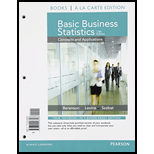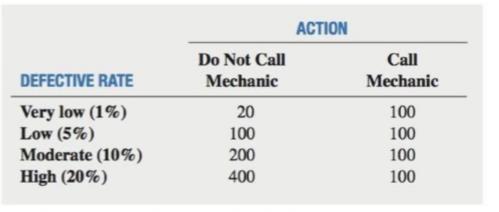
Concept explainers
A manufacturer of a brand of inexpensive felt-tip pens maintains a production process that produces 10,000 pens per day, In order to maintain the highest quality of this product, the manufacturer guarantees free replacement of any defective pen sold, Each defective pen produced costs 20 cents for the manufacturer to replace, Based on past experience, four rates of producing defective pens are possible:
Very low-
Low-
Moderate-
High-
The manufacturer can reduce the late of defective pens produced by having a mechanic �x the machines at the end of each day. This mechanic can reduce the rate to
A payoff table based on the daily production of 10,000 pens, indicating the replacement costs

Based on past experience, each defective rate is assumed to be equally likely to occur.
a. Construct a decision tree.
b. Construct an opportunity loss table.
c. Compute the expected monetary value (EMV) for calling and for not calling the mechanic.
d. Compute the expected opportunity loss (EOL) for calling and for not calling the mechanic.
e. Explain the meaning of the
f. Compute the return-to-risk ratio (RTRR) for calling and not calling the mechanic.
g. Based on the results of (c), (d), and (f), should the company call the mechanic? Why?
h. At the end of a day’s production, a sample of 15 pens is selected, and 2 are defective. Revise the prior probabilities in light of this sample information.
i. Use the revised probabilities in (h) to repeat (c) through (g).
Want to see the full answer?
Check out a sample textbook solution
Chapter 20 Solutions
Basic Business Statistics Student Value Edition Plus NEW MyLab Statistics with Pearson eText -- Access Card Package (13th Edition)
 Algebra: Structure And Method, Book 1AlgebraISBN:9780395977224Author:Richard G. Brown, Mary P. Dolciani, Robert H. Sorgenfrey, William L. ColePublisher:McDougal Littell
Algebra: Structure And Method, Book 1AlgebraISBN:9780395977224Author:Richard G. Brown, Mary P. Dolciani, Robert H. Sorgenfrey, William L. ColePublisher:McDougal Littell

